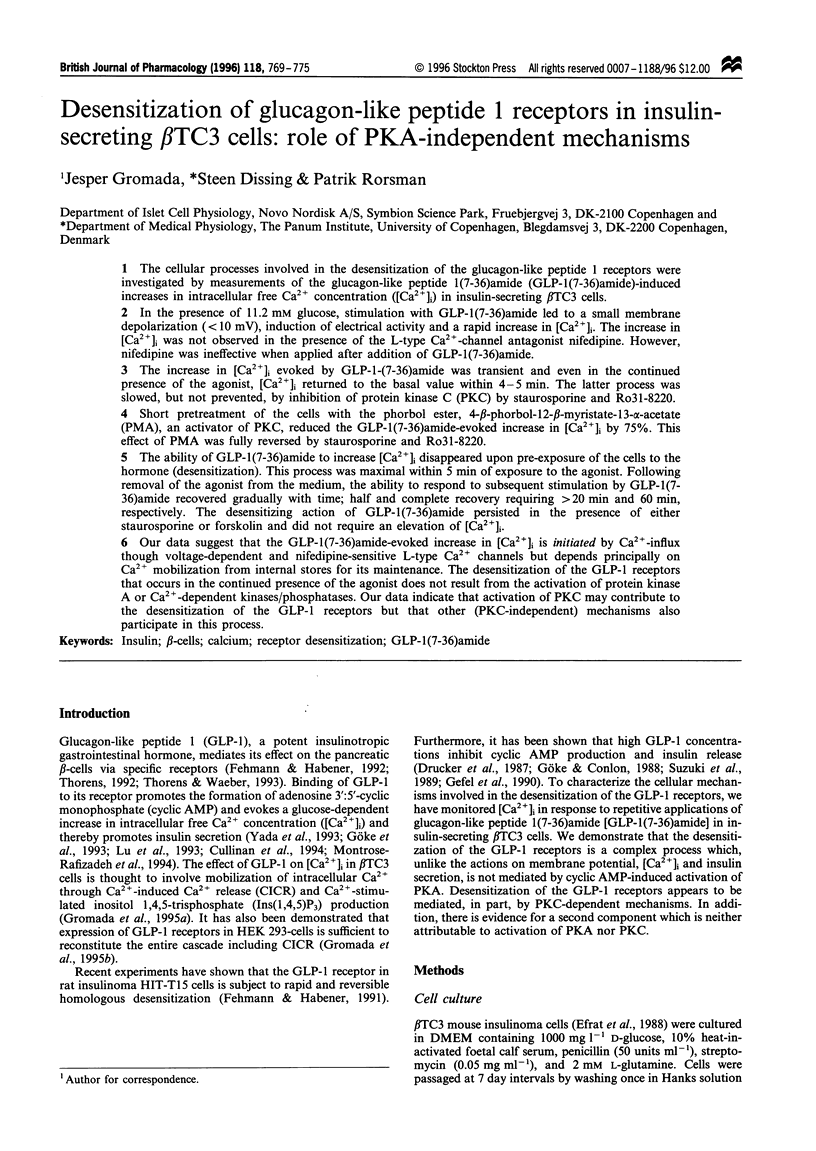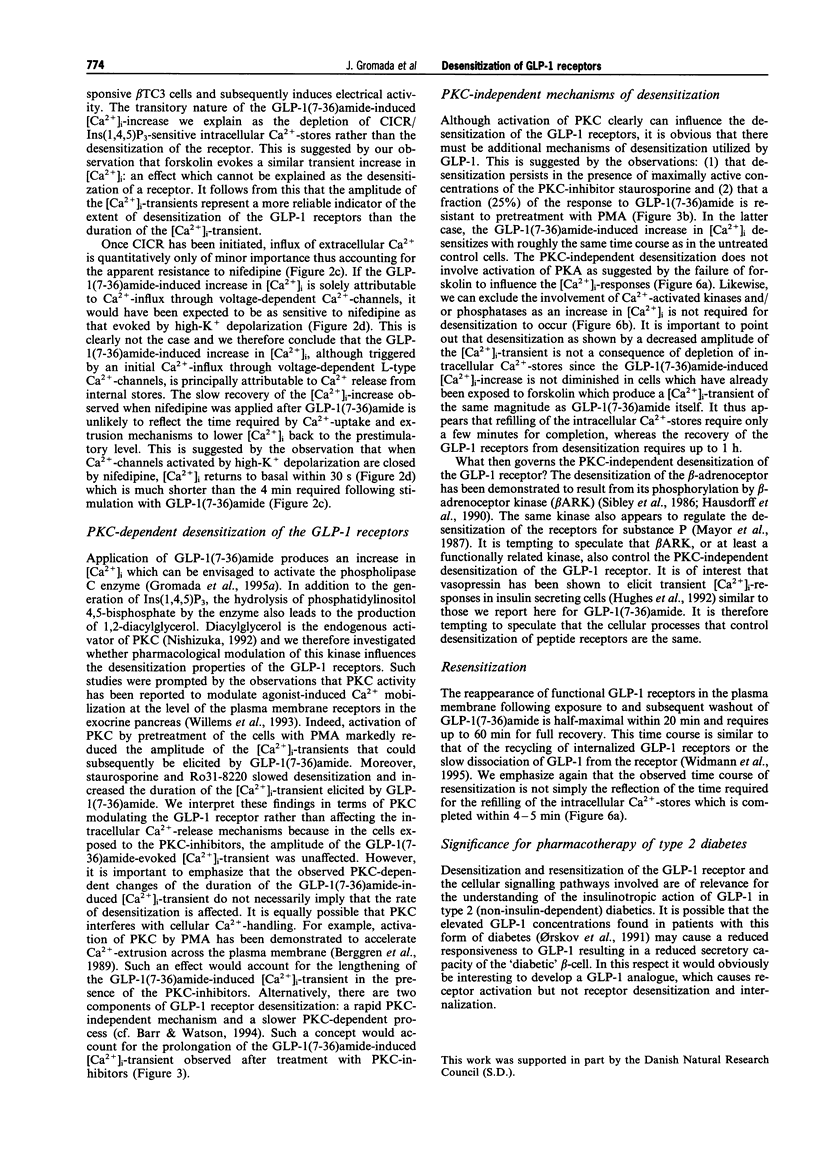Abstract
1. The cellular processes involved in the desensitization of the glucagon-like peptide 1 receptors were investigated by measurements of the glucagon-like peptide 1(7-36)amide (GLP-1(7-36)amide)-induced increases in intracellular free Ca2+ concentration ([Ca2+]i) in insulin-secreting beta TC3 cells. 2. In the presence of 11.2 mM glucose, stimulation with GLP-1(7-36)amide led to a small membrane depolarization (< 10 mV), induction of electrical activity and a rapid increase in [Ca2+]i. The increase in [Ca2+]i was not observed in the presence of the L-type Ca(2+)-channel antagonist nifedipine. However, nifedipine was ineffective when applied after addition of GLP-1(7-36)amide. 3. The increase in [Ca2+]i evoked by GLP-1-(7-36)amide was transient and even in the continued presence of the agonist, [Ca2+]i returned to the basal value within 4-5 min. The latter process was slowed, but not prevented, by inhibition of protein kinase C (PKC) by staurosporine and Ro31-8220. 4. Short pretreatment of the cells with the phorbol ester, 4-beta-phorbol-12-beta-myristate-13-alpha-acetate (PMA), an activator of PKC, reduced the GLP-1(7-36)amide-evoked increase in [Ca2+]i by 75%. This effect of PMA was fully reversed by staurosporine and Ro31-8220. 5. The ability of GLP-1(7-36)amide to increase [Ca2+]i disappeared upon pre-exposure of the cells to the hormone (desensitization). This process was maximal within 5 min of exposure to the agonist. Following removal of the agonist from the medium, the ability to respond to subsequent stimulation by GLP-1(7-36)amide recovered gradually with time; half and complete recovery requiring > 20 min and 60 min, respectively. The desensitizing action of GLP-1(7-36)amide persisted in the presence of either staurosporine or forskolin and did not require an elevation of [Ca2+]i. 6. Our data suggest that the GLP-1(7-36)amide-evoked increase in [Ca2+]i is initiated by Ca(2+)-influx though voltage-dependent and nifedipine-sensitive L-type Ca2+ channels but depends principally on Ca2+ mobilization from internal stores for its maintenance. The desensitization of the GLP-1 receptors that occurs in the continued presence of the agonist does not result from the activation of protein kinase A or Ca(2+)-dependent kinases/phosphatases. Our data indicate that activation of PKC may contribute to the desensitization of the GLP-1 receptors but that other (PKC-independent) mechanisms also participate in this process.
Full text
PDF






Selected References
These references are in PubMed. This may not be the complete list of references from this article.
- Ammälä C., Ashcroft F. M., Rorsman P. Calcium-independent potentiation of insulin release by cyclic AMP in single beta-cells. Nature. 1993 May 27;363(6427):356–358. doi: 10.1038/363356a0. [DOI] [PubMed] [Google Scholar]
- Barr A. J., Watson S. P. Protein kinase C mediates delayed inhibitory feedback regulation of human neurokinin type 1 receptor activation of phospholipase C in UC11 astrocytoma cells. Mol Pharmacol. 1994 Aug;46(2):266–273. [PubMed] [Google Scholar]
- Berggren P. O., Arkhammar P., Nilsson T. Activation of protein kinase C assists insulin producing cells in recovery from raised cytoplasmic Ca2+ by stimulating Ca2+ efflux. Biochem Biophys Res Commun. 1989 Nov 30;165(1):416–421. doi: 10.1016/0006-291x(89)91086-3. [DOI] [PubMed] [Google Scholar]
- Cullinan C. A., Brady E. J., Saperstein R., Leibowitz M. D. Glucose-dependent alterations of intracellular free calcium by glucagon-like peptide-1(7-36amide) in individual ob/ob mouse beta-cells. Cell Calcium. 1994 May;15(5):391–400. doi: 10.1016/0143-4160(94)90014-0. [DOI] [PubMed] [Google Scholar]
- Drucker D. J., Philippe J., Mojsov S., Chick W. L., Habener J. F. Glucagon-like peptide I stimulates insulin gene expression and increases cyclic AMP levels in a rat islet cell line. Proc Natl Acad Sci U S A. 1987 May;84(10):3434–3438. doi: 10.1073/pnas.84.10.3434. [DOI] [PMC free article] [PubMed] [Google Scholar]
- Efrat S., Linde S., Kofod H., Spector D., Delannoy M., Grant S., Hanahan D., Baekkeskov S. Beta-cell lines derived from transgenic mice expressing a hybrid insulin gene-oncogene. Proc Natl Acad Sci U S A. 1988 Dec;85(23):9037–9041. doi: 10.1073/pnas.85.23.9037. [DOI] [PMC free article] [PubMed] [Google Scholar]
- Fehmann H. C., Habener J. F. Homologous desensitization of the insulinotropic glucagon-like peptide-I (7-37) receptor on insulinoma (HIT-T15) cells. Endocrinology. 1991 Jun;128(6):2880–2888. doi: 10.1210/endo-128-6-2880. [DOI] [PubMed] [Google Scholar]
- Gefel D., Hendrick G. K., Mojsov S., Habener J., Weir G. C. Glucagon-like peptide-I analogs: effects on insulin secretion and adenosine 3',5'-monophosphate formation. Endocrinology. 1990 Apr;126(4):2164–2168. doi: 10.1210/endo-126-4-2164. [DOI] [PubMed] [Google Scholar]
- Gromada J., Dissing S., Bokvist K., Renström E., Frøkjaer-Jensen J., Wulff B. S., Rorsman P. Glucagon-like peptide I increases cytoplasmic calcium in insulin-secreting beta TC3-cells by enhancement of intracellular calcium mobilization. Diabetes. 1995 Jul;44(7):767–774. doi: 10.2337/diab.44.7.767. [DOI] [PubMed] [Google Scholar]
- Gromada J., Rorsman P., Dissing S., Wulff B. S. Stimulation of cloned human glucagon-like peptide 1 receptor expressed in HEK 293 cells induces cAMP-dependent activation of calcium-induced calcium release. FEBS Lett. 1995 Oct 9;373(2):182–186. doi: 10.1016/0014-5793(95)01070-u. [DOI] [PubMed] [Google Scholar]
- Grynkiewicz G., Poenie M., Tsien R. Y. A new generation of Ca2+ indicators with greatly improved fluorescence properties. J Biol Chem. 1985 Mar 25;260(6):3440–3450. [PubMed] [Google Scholar]
- Göke R., Conlon J. M. Receptors for glucagon-like peptide-1(7-36) amide on rat insulinoma-derived cells. J Endocrinol. 1988 Mar;116(3):357–362. doi: 10.1677/joe.0.1160357. [DOI] [PubMed] [Google Scholar]
- Göke R., Wagner B., Fehmann H. C., Göke B. Glucose-dependency of the insulin stimulatory effect of glucagon-like peptide-1 (7-36) amide on the rat pancreas. Res Exp Med (Berl) 1993;193(2):97–103. doi: 10.1007/BF02576216. [DOI] [PubMed] [Google Scholar]
- Hausdorff W. P., Caron M. G., Lefkowitz R. J. Turning off the signal: desensitization of beta-adrenergic receptor function. FASEB J. 1990 Aug;4(11):2881–2889. [PubMed] [Google Scholar]
- Holz G. G., 4th, Kühtreiber W. M., Habener J. F. Pancreatic beta-cells are rendered glucose-competent by the insulinotropic hormone glucagon-like peptide-1(7-37). Nature. 1993 Jan 28;361(6410):362–365. doi: 10.1038/361362a0. [DOI] [PMC free article] [PubMed] [Google Scholar]
- Hughes S. J., Carpinelli A., Niki I., Nicks J. L., Ashcroft S. J. Stimulation of insulin release by vasopressin in the clonal beta-cell line, HIT-T15: the role of protein kinase C. J Mol Endocrinol. 1992 Apr;8(2):145–153. doi: 10.1677/jme.0.0080145. [DOI] [PubMed] [Google Scholar]
- Lu M., Wheeler M. B., Leng X. H., Boyd A. E., 3rd The role of the free cytosolic calcium level in beta-cell signal transduction by gastric inhibitory polypeptide and glucagon-like peptide I(7-37). Endocrinology. 1993 Jan;132(1):94–100. doi: 10.1210/endo.132.1.8380389. [DOI] [PubMed] [Google Scholar]
- Mayor F., Jr, Benovic J. L., Caron M. G., Lefkowitz R. J. Somatostatin induces translocation of the beta-adrenergic receptor kinase and desensitizes somatostatin receptors in S49 lymphoma cells. J Biol Chem. 1987 May 15;262(14):6468–6471. [PubMed] [Google Scholar]
- Montrose-Rafizadeh C., Egan J. M., Roth J. Incretin hormones regulate glucose-dependent insulin secretion in RIN 1046-38 cells: mechanisms of action. Endocrinology. 1994 Aug;135(2):589–594. doi: 10.1210/endo.135.2.8033807. [DOI] [PubMed] [Google Scholar]
- Nishizuka Y. Intracellular signaling by hydrolysis of phospholipids and activation of protein kinase C. Science. 1992 Oct 23;258(5082):607–614. doi: 10.1126/science.1411571. [DOI] [PubMed] [Google Scholar]
- Nishizuka Y. The role of protein kinase C in cell surface signal transduction and tumour promotion. Nature. 1984 Apr 19;308(5961):693–698. doi: 10.1038/308693a0. [DOI] [PubMed] [Google Scholar]
- Orskov C., Jeppesen J., Madsbad S., Holst J. J. Proglucagon products in plasma of noninsulin-dependent diabetics and nondiabetic controls in the fasting state and after oral glucose and intravenous arginine. J Clin Invest. 1991 Feb;87(2):415–423. doi: 10.1172/JCI115012. [DOI] [PMC free article] [PubMed] [Google Scholar]
- Rae J., Cooper K., Gates P., Watsky M. Low access resistance perforated patch recordings using amphotericin B. J Neurosci Methods. 1991 Mar;37(1):15–26. doi: 10.1016/0165-0270(91)90017-t. [DOI] [PubMed] [Google Scholar]
- Sibley D. R., Strasser R. H., Benovic J. L., Daniel K., Lefkowitz R. J. Phosphorylation/dephosphorylation of the beta-adrenergic receptor regulates its functional coupling to adenylate cyclase and subcellular distribution. Proc Natl Acad Sci U S A. 1986 Dec;83(24):9408–9412. doi: 10.1073/pnas.83.24.9408. [DOI] [PMC free article] [PubMed] [Google Scholar]
- Suzuki S., Kawai K., Ohashi S., Mukai H., Yamashita K. Comparison of the effects of various C-terminal and N-terminal fragment peptides of glucagon-like peptide-1 on insulin and glucagon release from the isolated perfused rat pancreas. Endocrinology. 1989 Dec;125(6):3109–3114. doi: 10.1210/endo-125-6-3109. [DOI] [PubMed] [Google Scholar]
- Tamaoki T., Nomoto H., Takahashi I., Kato Y., Morimoto M., Tomita F. Staurosporine, a potent inhibitor of phospholipid/Ca++dependent protein kinase. Biochem Biophys Res Commun. 1986 Mar 13;135(2):397–402. doi: 10.1016/0006-291x(86)90008-2. [DOI] [PubMed] [Google Scholar]
- Thorens B. Expression cloning of the pancreatic beta cell receptor for the gluco-incretin hormone glucagon-like peptide 1. Proc Natl Acad Sci U S A. 1992 Sep 15;89(18):8641–8645. doi: 10.1073/pnas.89.18.8641. [DOI] [PMC free article] [PubMed] [Google Scholar]
- Thorens B., Waeber G. Glucagon-like peptide-I and the control of insulin secretion in the normal state and in NIDDM. Diabetes. 1993 Sep;42(9):1219–1225. doi: 10.2337/diab.42.9.1219. [DOI] [PubMed] [Google Scholar]
- Widmann C., Dolci W., Thorens B. Agonist-induced internalization and recycling of the glucagon-like peptide-1 receptor in transfected fibroblasts and in insulinomas. Biochem J. 1995 Aug 15;310(Pt 1):203–214. doi: 10.1042/bj3100203. [DOI] [PMC free article] [PubMed] [Google Scholar]
- Willems P. H., Van Hoof H. J., Van Mackelenbergh M. G., Hoenderop J. G., Van Emst-De Vries S. E., De Pont J. J. Receptor-evoked Ca2+ mobilization in pancreatic acinar cells: evidence for a regulatory role of protein kinase C by a mechanism involving the transition of high-affinity receptors to a low-affinity state. Pflugers Arch. 1993 Jul;424(2):171–182. doi: 10.1007/BF00374609. [DOI] [PubMed] [Google Scholar]
- Yada T., Itoh K., Nakata M. Glucagon-like peptide-1-(7-36)amide and a rise in cyclic adenosine 3',5'-monophosphate increase cytosolic free Ca2+ in rat pancreatic beta-cells by enhancing Ca2+ channel activity. Endocrinology. 1993 Oct;133(4):1685–1692. doi: 10.1210/endo.133.4.8404610. [DOI] [PubMed] [Google Scholar]


